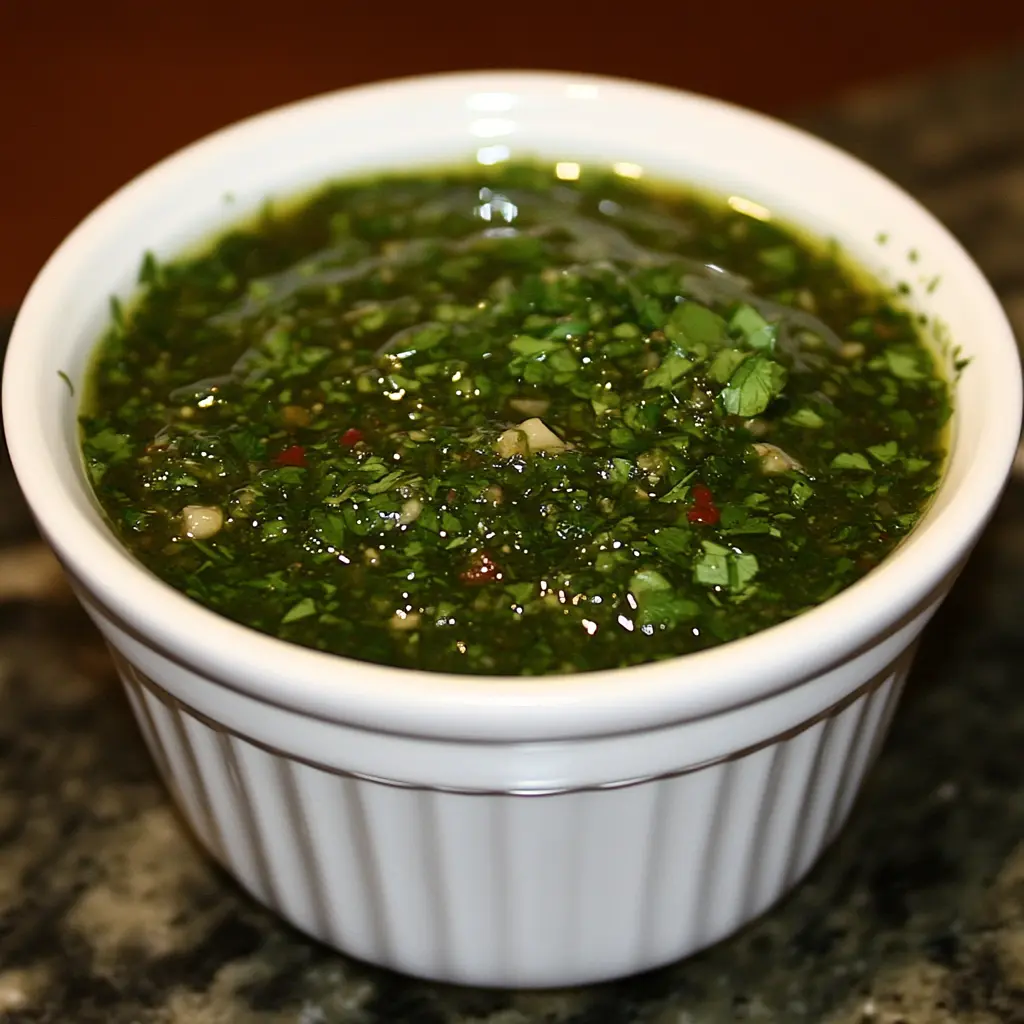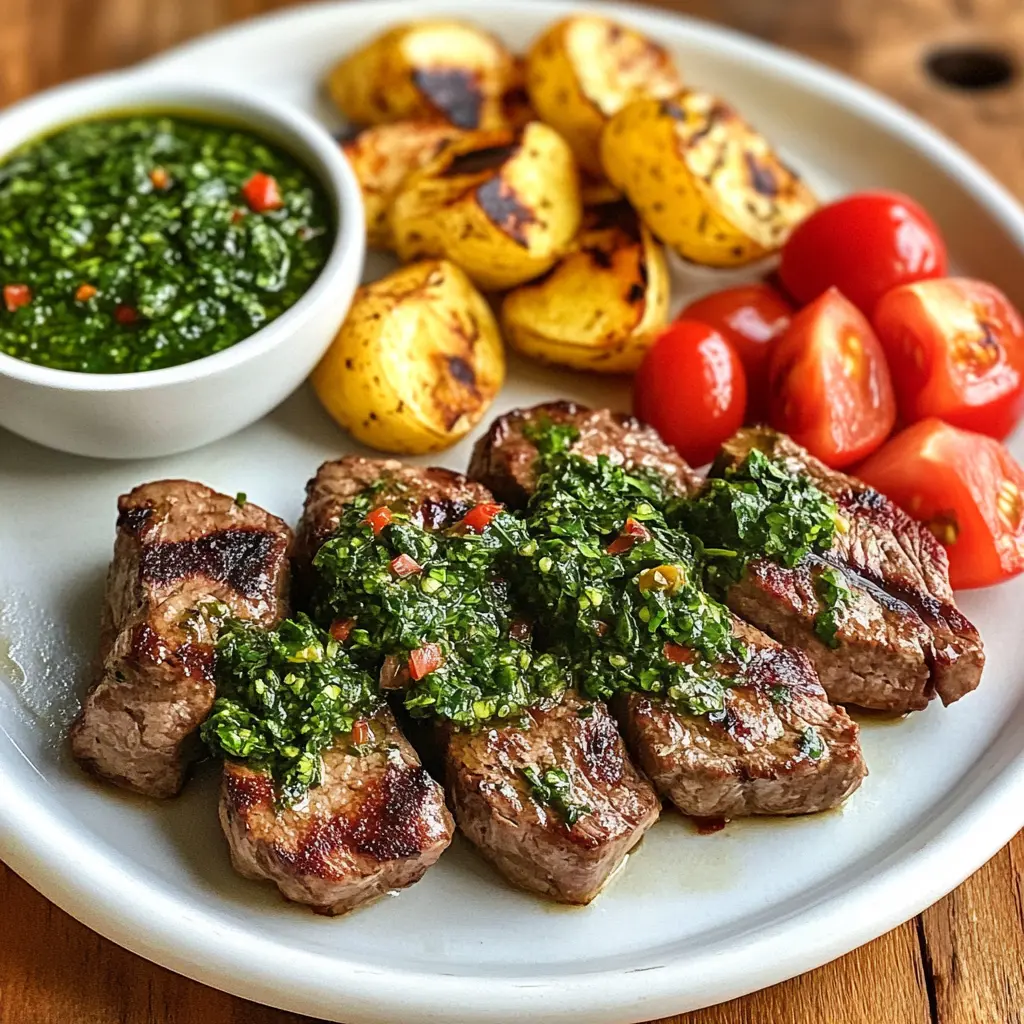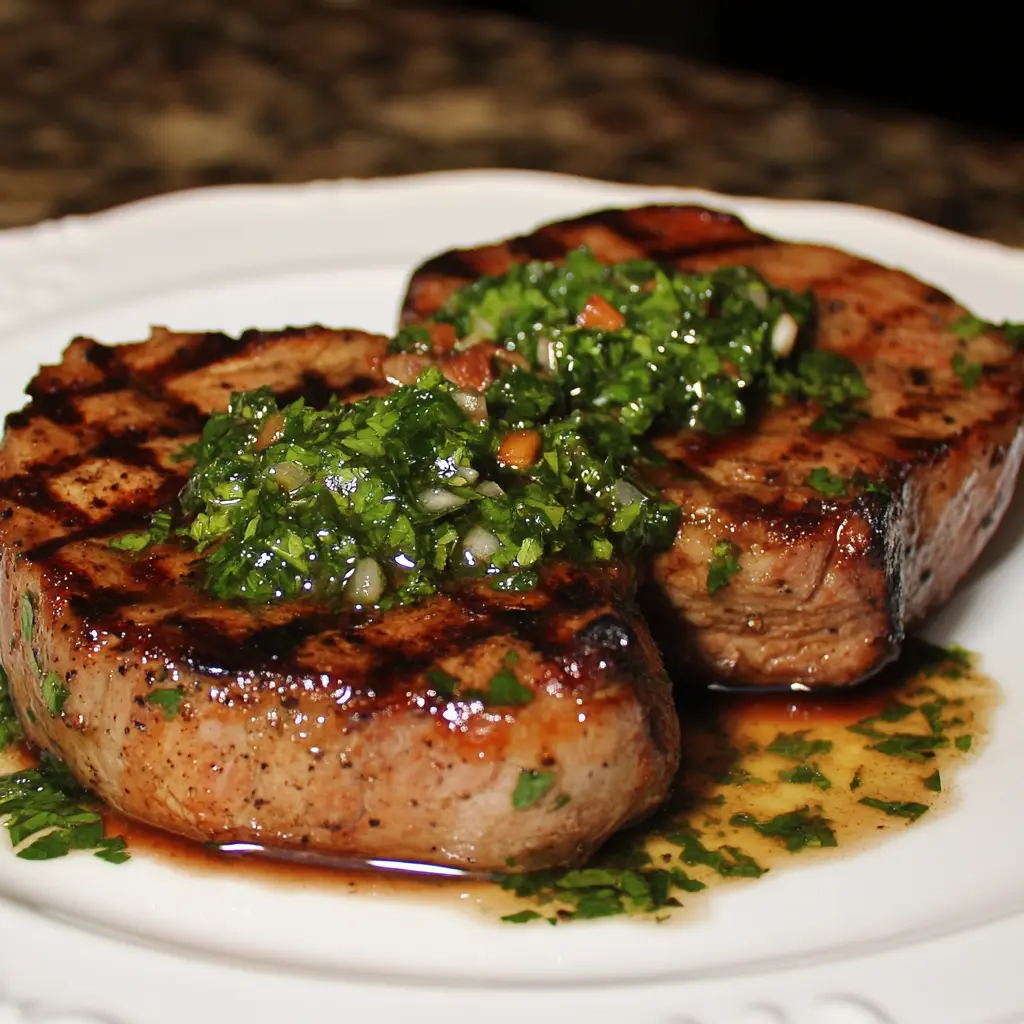What is Chimichurri Sauce?
Chimichurri sauce is a vibrant, herbaceous, and tangy green condiment that hails from South America, most famously Argentina and Uruguay. It’s known for its zesty punch and versatility in the kitchen, and it’s commonly used as a marinade or topping for grilled meats.
Origins and History of Chimichurri
The roots of Chimichurri trace back to Argentina in the 19th century. It was traditionally made by gauchos (South American cowboys) as a way to flavor their grilled meats. The name “Chimichurri” is said to have various origins—some link it to a Basque word, others to an Irishman named Jimmy Curry. Either way, it’s now a beloved staple across the globe.
Traditional vs. Modern Versions
Traditional Chimichurri sticks closely to parsley, garlic, oregano, red pepper flakes, vinegar, and oil. Modern spins may include cilantro, shallots, or lemon juice. While variations are plenty, the heart of the sauce remains unchanged: bold, fresh, and full of character.
Why Chimichurri is So Popular

Versatility in Cooking
One of the biggest reasons for Chimichurri’s global appeal is its flexibility. Whether you’re drizzling it over steak, spooning it onto veggies, or mixing it into spreads, this green sauce never disappoints.
- As a marinade: Perfect for beef, chicken, shrimp, or tofu.
- As a dip or sauce: Ideal for empanadas, bread, or grilled halloumi.
- As a finishing touch: A bright and punchy garnish that enhances any dish.
Nutritional Benefits
Beyond its taste, Chimichurri is also good for you. Made with heart-healthy olive oil, anti-inflammatory garlic, and antioxidant-rich herbs, it’s a smart choice for clean eating.
| Ingredient | Health Benefit |
|---|---|
| Parsley | Rich in Vitamin C and K |
| Garlic | Supports immune health |
| Olive Oil | Contains healthy fats |
| Oregano | Anti-bacterial and antioxidant |
| Red Pepper Flakes | Boosts metabolism |
Key Ingredients in Authentic Chimichurri Sauce
Understanding the ingredients is essential to mastering the recipe.
Fresh Herbs: Parsley and Oregano
Flat-leaf parsley is the star of the show, bringing freshness and a mild bitterness that balances the oil and vinegar. Oregano, preferably fresh, adds an earthy aroma that deepens the flavor.
Tip: Dried oregano can be used if fresh isn’t available, but fresh herbs yield the best results.
The Power of Garlic and Vinegar
Garlic gives Chimichurri its bold kick, while red wine vinegar offers the tangy punch that cuts through the richness of meat. These two are the sauce’s backbone.
Olive Oil – The Liquid Gold
Extra virgin olive oil binds everything together, creating a smooth and flavorful base. It acts as both a carrier and a flavor enhancer.
Optional Enhancers: Lemon Juice and Chili
While not always traditional, lemon juice adds brightness and a citrusy lift. A bit of chili or extra red pepper flakes brings the heat for spice lovers.
Step-by-Step Instructions to Make Chimichurri
Crafting the perfect Chimichurri is as much about technique as it is about ingredients.
Manual Chopping vs. Food Processor
You can either finely chop the herbs and garlic by hand for a rustic texture or use a food processor for a quicker, slightly smoother version. Just be careful not to puree—the sauce should have visible bits.
Why it matters: Over-processing can result in a paste instead of a sauce.
Mixing and Emulsifying Techniques
After chopping, stir in red wine vinegar, red pepper flakes, salt, and pepper. Slowly drizzle in the olive oil while stirring to help emulsify the mixture. This creates a harmonious blend rather than a separated oil layer.
Resting Time for Maximum Flavor
Let the sauce sit at room temperature for 15–30 minutes before serving. This resting time allows flavors to meld and deepen, making the Chimichurri more robust and balanced.
Chef’s Pro Tips for the Best Chimichurri Ever
Why Fresh Herbs Are Non-Negotiable
Using fresh flat-leaf parsley and oregano is key. Dried parsley just doesn’t have the same aroma or flavor intensity. Always rinse and dry herbs thoroughly before chopping to avoid water diluting your sauce.
Adjusting Heat and Acidity
Taste as you go. Some may prefer more vinegar for tang or more red pepper for heat. Start with the basic ratios and adjust to match your personal preferences.
Serving Ideas for Chimichurri Sauce

Chimichurri shines when paired with grilled or roasted foods. Here are some delicious ways to enjoy it:
- Grilled Steak – The classic pairing.
- Roast Chicken or Turkey – Adds a bright contrast.
- Vegetables – Roasted potatoes, grilled eggplant, or zucchini come alive.
- Seafood – Spoon over grilled shrimp or salmon.
- Sandwich Spread – Mix with mayo or Greek yogurt for a flavorful spread.
- Flatbreads and Empanadas – Perfect dipping sauce for handheld bites.
Storage and Shelf Life
Store leftover Chimichurri in an airtight container in the refrigerator for up to 3–4 days. The olive oil may solidify when chilled; just bring it to room temperature and stir before using.
| Storage Tip | Duration |
|---|---|
| Refrigerator (airtight jar) | 3–4 days |
| Freezer (ice cube trays) | 1 month (for marinating use) |
Regional Variations of Chimichurri Sauce
While Argentine Chimichurri is the most well-known, several Latin American countries have their own unique interpretations of this iconic sauce.
Uruguayan Chimichurri
Uruguayan versions often include a wider variety of dried herbs and sometimes incorporate a touch of sweetness using sugar or even a splash of brandy. It tends to have a slightly thicker consistency and is used more as a basting sauce for barbecues.
Paraguayan & Brazilian Influences
In Paraguay and southern Brazil, Chimichurri might include chopped onions, bell peppers, and even tomatoes. These regional spins offer a chunkier texture, closer to a relish.
Cultural Note: In these regions, Chimichurri isn’t just a sauce—it’s a ritual. Passed down through generations, every family may have their “secret blend” that adds a personal touch to meals.
How Chimichurri Enhances Different Cuisines

Argentine Asado (Grill Culture)
Chimichurri plays a starring role in the traditional asado, Argentina’s revered barbecue tradition. A slab of grilled beef or chorizo isn’t complete without a generous spoonful of Chimichurri. It balances the fattiness of grilled meats with its acidity and herbal freshness.
Mediterranean Meals
Its herbal and garlicky profile pairs effortlessly with Mediterranean foods. Try it with:
- Grilled eggplant or zucchini
- Lamb kebabs
- Falafel wraps topped with Chimichurri-yogurt sauce
North American BBQ
Replace BBQ sauce with Chimichurri for a lighter, fresher option on:
- Pulled pork sandwiches
- Smoked brisket
- Grilled corn on the cob
Chimichurri as a Marinade vs. Finishing Sauce
Chimichurri can play multiple roles in your kitchen, depending on when you use it:
| Usage | When to Apply | Best For |
|---|---|---|
| Marinade | Before grilling – let meat soak for 1–2 hours | Beef, chicken, tofu |
| Basting Sauce | During grilling for moisture and flavor | Skewers, kebabs |
| Finishing Sauce | After cooking, as a final drizzle | Roasted veggies, steak, eggs |
Pro Tip: Always make a separate batch if using as a marinade to avoid cross-contamination.
Creative Ways to Use Chimichurri Beyond Grilling
Think Chimichurri is only for meat? Think again! Here are 10 unexpected yet delicious ways to integrate it into your everyday meals:
- Breakfast Eggs – Drizzle over sunny-side-up eggs.
- Pizza Topping – Add a few spoonfuls on a white pizza or Margherita slice.
- Avocado Toast – Skip the usual hot sauce and try Chimichurri instead.
- Pasta Dressing – Use it as a fresh pesto alternative.
- Rice Bowls – Great with quinoa, lentils, or wild rice.
- Burger Spread – Mix into mayo for a zesty burger topper.
- Grilled Cheese Dip – Elevates a classic comfort food.
- Baked Fish Glaze – Spoon onto tilapia, cod, or salmon.
- Taco Sauce – Replace salsa verde for a fresh twist.
- Soup Garnish – Swirl into creamy soups for color and flavor.
Flavor Pairing Guide: What Goes Best with Chimichurri
To truly appreciate the culinary power of Chimichurri, it helps to understand its best flavor companions:
| Food | Why It Works |
|---|---|
| Beef | Cuts through rich, fatty flavors |
| Chicken | Brightens mild, lean meat |
| Shrimp | Balances sweet and briny taste |
| Eggs | Adds zest and herbaceous lift |
| Root Vegetables | Enhances earthy sweetness |
| Beans & Lentils | Introduces acidity and freshness |
| Grilled Cheese | Cuts through creaminess with tang |
How to Customize Chimichurri to Suit Any Palate
The beauty of Chimichurri is its adaptability. Here’s how you can tailor it:
For Heat Lovers:
- Add minced fresh chili (jalapeño, serrano, or Thai chili)
- Double the red pepper flakes
For Mild Palates:
- Use less garlic or blanch garlic before mincing
- Skip or reduce red pepper flakes
For a Smoother Sauce:
- Add a splash of warm water
- Blend briefly with an immersion blender
For Extra Freshness:
- Mix in mint or cilantro
- Finish with lemon or lime zest
Wine and Beverage Pairings with Chimichurri
Due to its acidity and herbal nature, Chimichurri pairs beautifully with:
Red Wines:
- Malbec – The classic Argentine match
- Tempranillo – Earthy and robust
- Cabernet Franc – Herbaceous tones match well
White Wines:
- Sauvignon Blanc – Crisp and citrusy
- Albariño – Refreshing and floral
Non-Alcoholic Pairings:
- Sparkling water with lime
- Cold yerba mate
- Cucumber-mint lemonade
How to Scale Chimichurri for Crowds
Cooking for a group? Here’s a simple scaling chart:
| Serving Size | Parsley | Oregano | Garlic | Oil | Vinegar |
|---|---|---|---|---|---|
| 2–4 people | 1 cup | ¼ cup | 4 cloves | ½ cup | 2 tbsp |
| 8–10 people | 2 cups | ½ cup | 8 cloves | 1 cup | 4 tbsp |
| 15–20 people | 3 cups | ¾ cup | 12 cloves | 1.5 cups | 6 tbsp |
Always taste and adjust — freshness can vary between herb bunches!
Environmental Benefits of Homemade Chimichurri
Making your own Chimichurri isn’t just delicious — it’s eco-friendly too!
- No plastic bottles like store-bought dressings
- Minimal processing reduces your carbon footprint
- Supports local produce when herbs are sourced from farmer’s markets or home gardens
Frequently Asked Questions (FAQs)
1. Can I make Chimichurri ahead of time?
Yes! In fact, letting it sit for a few hours enhances the flavor. Just store it in the fridge and bring it to room temperature before serving.
2. Can Chimichurri be frozen?
Absolutely. Freeze in small portions using an ice cube tray. Thaw as needed, but note it’s best used for marinades post-freezing.
3. What protein pairs best with Chimichurri?
Grilled steak is traditional, but it also pairs beautifully with chicken, lamb, pork, fish, and even tofu.
4. Is Chimichurri spicy?
It has a mild kick from red pepper flakes. You can adjust the heat level to your preference by adding more or less.
5. Can I use cilantro in Chimichurri?
Yes, many modern variations include cilantro for a more Latin-inspired twist. It’s not traditional, but it’s delicious.
6. Is Chimichurri gluten-free and vegan?
Yes, it’s naturally gluten-free and vegan as long as you use gluten-free vinegar.
7. Can I make Chimichurri oil-free?
Yes, but the texture and flavor will change. You can use water or veggie broth as a base, though it won’t emulsify the same way.
8. What’s the difference between Chimichurri and Pesto?
Pesto includes nuts, cheese, and basil, while Chimichurri focuses on parsley, vinegar, and no dairy or nuts.
9. Is Chimichurri keto or paleo-friendly?
Yes, it’s naturally both! It’s low-carb, free of added sugars, and contains healthy fats.
10. Can I use a blender?
A food processor or hand chopping is better. Blenders often make it too smooth — Chimichurri should have texture
Conclusion: Elevate Your Meals with Authentic Chimichurri Sauce
Whether you’re looking to wow your guests at a summer barbecue or add a flavor punch to your weeknight dinners, Authentic Chimichurri Sauce is the answer. It’s fast, fresh, and unbelievably versatile. With a handful of fresh ingredients and a few minutes of prep, this vibrant green sauce can take any meal from basic to brilliant.



8 thoughts on “Authentic Chimichurri Sauce – The Ultimate No-Cook Green Sauce Recipe”